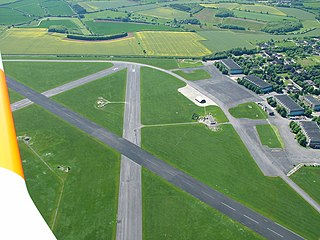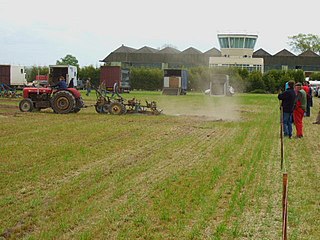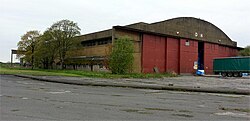
Royal Air Force Dishforth or more simply RAF Dishforth is a former Royal Air Force station near Thirsk in North Yorkshire, England. Opened in 1936, the base was used as a bomber airfield during the Second World War with both British and Canadian squadrons flying missions from the airfield. After the war, the base was used by various squadrons and training units before being disposed of in 1992 and handed over to the Army Air Corps.
RAF Carlisle was a Royal Air Force establishment, now closed after being used for a variety of roles over a period of fifty eight years and formerly located 2 mi (3.2 km) north of Carlisle city centre in Cumbria, England.

Royal Air Force Finningley or RAF Finningley was a Royal Flying Corps and Royal Air Force station at Finningley, in the Metropolitan Borough of Doncaster, South Yorkshire, England. The station straddled the historic county boundaries of both Nottinghamshire and the West Riding of Yorkshire.

Royal Air Force Hooton Park or more simply RAF Hooton Park, on the Wirral Peninsula, Cheshire, is a former Royal Air Force station originally built for the Royal Flying Corps in 1917 as a training aerodrome for pilots in the First World War. During the early/mid-1930s, it was one of the two airfields handling scheduled services for the Merseyside region. Hooton Park was home to No. 610 Squadron and, post Second World War, to No. 611 and No. 663 (AOP) Squadron.

Royal Air Force Little Rissington or more simply RAF Little Rissington is an Royal Air Force satellite station in Gloucestershire, England. It was once home to the Central Flying School, the Vintage Pair and the Red Arrows.

Royal Air Force Goxhill or RAF Goxhill is a former Royal Air Force station located east of Goxhill, on the south bank of the Humber Estuary, opposite the city of Kingston upon Hull, in north Lincolnshire, England.

Royal Air Force Scorton or more simply RAF Scorton is a former Royal Air Force satellite station located next to the village of Scorton in North Yorkshire, England. The base was opened in October 1939 as part of 13 Group RAF Fighter Command and a satellite station of RAF Catterick. It was used by the Royal Air Force, the Royal Canadian Air Force, and the United States Army Air Forces Ninth Air Force during the war.

Barrow/Walney Island Airport is located on Walney Island, 1.5 NM northwest of the centre of Barrow-in-Furness, Cumbria, England. The airport is owned by BAE Systems, who operate private communication flights to locations across the United Kingdom and expanded the airport with new infrastructure and terminal buildings in 2018. The Lakes Gliding Club also operates out of the airport.

Royal Air Force Lindholme or more simply RAF Lindholme is a former Royal Air Force station in South Yorkshire, England. It was located 3.9 miles (6.3 km) south of Thorne and 6.9 miles (11.1 km) north east of Doncaster and was initially called RAF Hatfield Woodhouse.
Royal Air Force Full Sutton or RAF Full Sutton is a former Royal Air Force station located 2 miles (3.2 km) south east of Stamford Bridge, East Riding of Yorkshire and 4.7 miles (7.6 km) north west of Pocklington, East Riding of Yorkshire, England. The base did not open until May 1944, and so was the last airfield built for Bomber Command.
Royal Air Force Grangemouth or more simply RAF Grangemouth is a former Royal Air Force station located 3 mi (4.8 km) north east of Falkirk, Stirlingshire, Scotland.

Royal Air Force Llandwrog, or more simply RAF Llandwrog, is a former Royal Air Force station located near the village and in the community of Llandwrog, situated 3.5 miles (6 km) southwest of Caernarfon, Gwynedd, Wales.
Royal Air Force Rhoose, or more simply RAF Rhoose, is a former Royal Air Force satellite station located near Rhoose, 10 miles (16 km) south west of Cardiff and 2 miles (3 km) east of RAF St Athan, Vale of Glamorgan, Wales. It was first used by an Operational Training Unit in April 1942, as additional space, until May 1943. The airfield then remained unused until February 1944, when an Air Gunnery School operated out of RAF Rhoose until August 1944. It was then placed into care and maintenance until transferred to RAF Maintenance Command in November 1944. After the Second World War, the airfield became a sub-site of a Maintenance Unit. The MU and airfield closed in 1948.

Royal Air Force Rufforth or RAF Rufforth is a former Royal Air Force station located near Rufforth in North Yorkshire, England. It was used by only one operational squadron on long-range bombing missions during the Second World War, with most flying dedicated to conversion units under the auspices of nearby RAF Marston Moor. Post-war, the RAF used the site to house maintenance units, gliding schools and observation flights. It was completely disposed of by the MoD in 1981, and now is used for civilian light aircraft and glider flying.

RAF Holme-on-Spalding Moor, or more simply RAF Holme is a former Royal Air Force station located in the East Riding of Yorkshire, England.

Royal Air Force Balado Bridge or more simply RAF Balado Bridge is a former Royal Air Force station located 2 miles west of Kinross, in central Scotland. It opened in 1942 as a satellite airfield to RAF Grangemouth, and closed in 1957. It has since served as a NATO satellite station, a microlight flying base, and as the venue for the T in the Park music festival.
Royal Air Force Dumfries or more simply RAF Dumfries was a former Royal Air Force station located near Dumfries, Dumfries and Galloway Scotland. The airfield opened on 17 June 1940 and was sold in 1960 to a private firm.
RAF Riccall is a former Royal Air Force airfield located 3.1 miles (5 km) north east of Selby, North Yorkshire and 7.9 miles (12.7 km) south west of Elvington, North Yorkshire, England.

Royal Air Force Hixon, or more simply RAF Hixon, was a Royal Air Force station located on the north western edge of the village of Hixon in Staffordshire, England. The airfield was 7.5 miles (12.1 km) east of Stafford and bounded at the west and north by railways.

The Type-C hangar is a specific design of aircraft hangar built by the Royal Air Force during its expansion period of the 1930s. The hangar type generally measured 300 feet (91 m) in length, with a width of 152 feet 5 inches (46.46 m), and a clear height of 35 feet 4 inches (10.77 m). Whilst the type was designed, built and used during the expansion programme, installation of type-C hangars continued into the Second World War. By 1944, it was determined that in 64 RAF expansion period airfields, which were open at that time, at least one type-C hangar was present.















